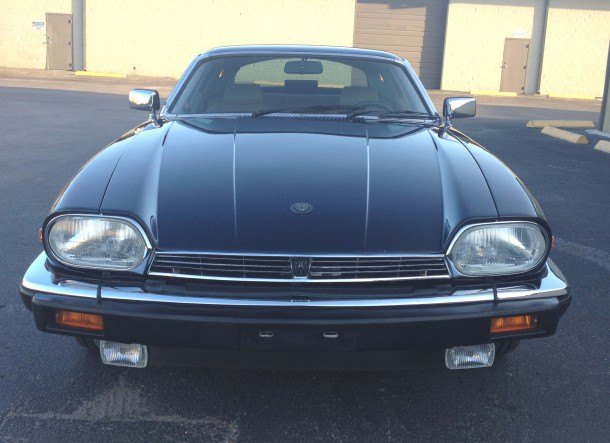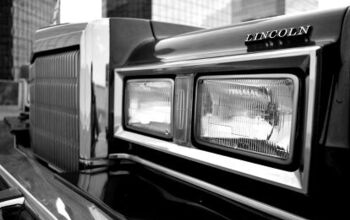Vellum Venom: 1988 Jaguar XJS

One of my CCS Design professors had a saying: it’s all about Proportion, Proportion, Proportion. Just typing that makes me cringe. Perhaps it’s a popular phrase for car design wonks, or a riff from the restaurant business.
However, the theory is valid: Imagine if the Pontiac Aztek was proportioned a la Range Rover Evoque. It’s a fair notion. If that were the case, the Aztek may not have been bound for every “Top 100 Ugliest Cars” list since 2000.
Proving the theory is this 1988 Jaguar XJS. It’s a beautiful grand touring coupe because the proportions are right.
Aside from the US-spec bumper, the XJS’ head-on shot is properly stunning. The hood sweeps back for days while its are headlights thrust forward.
Nothing interferes with this 1970s-era coupe (designed initially by Malcolm Sayer); not the barely-there grille, nor the exposed wiper arms. Even the large, outlandish, windtunnel-averse mirrors seem logical.
The bumpers are a ground hugging foundation, but in Europe the flow must be crazy from this angle!
It’s a shame this photo angle of a modern car can’t exist without shooting from a ladder. Take your pedestrian safety regulations and shove it. Or not.
Raked back headlights would have been a nice hat-tip to the outgoing model, but later (US-spec) models took flush mounted halogen lights and made it work.
The US-spec bumper’s clumsy and chunky demeanor is evident. The curve apes the hood and fenders, possibly with complimentary vanishing points.
The side shot is dicey: poorly integrated fog lamps, two thicknesses of bumper padding, and ill-proportioned amber lights. I suspect the latter were Jaguar (or British Leyland) parts bin affairs.
Form fitting signal/marker lights were commonplace by 1988, just not in Coventry. And is the black bumper pad that vulgar?
But the big bumper keeps eyes from noticing the two metal pieces (three total, natch) making the chrome bumper. Lower insurance costs uber alles, baby!
There’s a jagged plastic bit between the bumper and the grille, and this one’s been hacked by a shady wrench to expose a bumper adjustment point. Awful!
But there’s no excuse for factory exposed rivets and a Phillips head screw. By 1988, even cheaper Luxo-Coupes from Detroit knew that.
Ditto exposed screws on lenses. Fine for the 1986 Hyundai Excel, but not at this price point.
But proof of V-12 motivation and that lovely Jag’s Head emblem is worth the cost of admission. The Jag head should be further down to accentuate the hood’s length, but I reckon there’s a hole underneath to change your growler into a leaper for mega brand recognition behind the wheel.
Now remember what my prof said: it’s all about Proportion, Proportion, Proportion. Step back and the details blur into a properly lovely cab-backward design.
It’s not just about proportioning: Exposed cowls (and those panel gaps!) on a luxury vehicle sold in 1988 is inexcusable. Let’s assume the last owner was behind the oddly sized wiper blades.
A cowl this tacky must sport exposed attaching hardware, thinking otherwise is rude.
That dash-to-axle ratio is a middle finger to your Bauhausian SEC Benzos, your hot-rod LSCs and your Six-Sigma Supra Turbos.
Even that thrusting door cutline accentuates the cab backward design and perhaps also more room for ingress.
Now what’s that shiny thing behind the cutline, and how is it held to the door?
Ah, yes, exposed screws. (poop emoji) What decade did this Jag come from?
The door handles are lean yet powerfully assertive, just like the hood. And they aren’t screwed on from the outside.
These deep dish, thick legged, five-spokers are quite the business. Clean, subtly sculptured and the right amount of eyeliner around the spokes for excitement without looking clumpy and dumpy.
It’s like a minimalist museum space for a detailed, gold toned masterpiece in the center of the room.
Cross past the fender and the XJS rewards with a classic chrome windscreen flowing back to … why is that B- and C-pillar so flat black, squared off and brutally 1970s?
Because it was designed in the 1970s. The XJS looks muscular from a dog’s eye view!
The A-pillar to roof juncture shows a generational mashup: Metal crafted, old-school chrome and 1970s flat-black minimalist modernism do not play well together.
There are three different chrome trim thicknesses here. Two sizes could’ve cleaned things up and one size (preferred) would’ve made the XJS go full on 1970s Porsche 928.
Preferences in chrome thickness aside, the C-pillar needs more glass to harmonize with the body. Even if it’s non-functional, a slipcover over the structure would go a long way.
What a tragic transition from A-to-C pillars: part iconic E-type, part classical British riff on the Porsche 928’s minimalist greenhouse. The 928 — or any other big dollar 1970s creation — references are not unfair. It would streamline the XJS.
The chrome end caps connecting horizontal and vertical trim are decidedly old school.
The top of the C-pillar’s chrome trim sports an integrated rain gutter. Perhaps “integrated” is incorrect as there were better ways to keep rain sheeting down side glass back then.
Jaguar thought faux-vinyl upholstery was a better idea than more glass or paint? Rubbish!
If you forget the A-pillar exists, the chrome/faux-vinyl looks muscular, flowing logically to the fastback C-pillar.
Yes! Imagine the XJS with a thin band of chrome around the A-pillar and the windscreen. It’d look period correct — yet properly British — from here.
But it didn’t happen. Instead, we’re left with a hodgepodge of decades blending like oil and water.
Let’s not overlook the lower half, as the XJS remains clutter free. It tells your eyes, “Nothing to see here, go admire the cab backward design.”
But these well-crafted body side protectors have a significant crush space not seen on many of its competitors. The Mercedes SEC did it better.
Stretched around a “D-shaped” back window (a Jaguar hallmark), the XJS’ C-pillar extends far, far past where most coupes give up. Lovely.
Faaaaaar back! And nice work putting the CHMSL so cleanly on the window!
Is this a 1950s Mark II Jaguar or a 1980s XJS? A rhetorical question showing how one builds a brand with DNA lasting for decades.
Simply magnificent. If only we could craft sheet metal like this again.
More chrome end caps and their classic “British Charm.”
Too bad about the fuel door’s jarring appearance: extending to vanishing points with no harmony relative to the quarter window.
But step back again and admire the proportions. There’s a strong dose of tumblehome for a lovely contour. Too bad the boneheaded chrome rain gutters ruin the flow once more.
And the quarter window/vinyl thingie is far too boxy compared to the Ferrari Testarossa’s fantastic integration of an angular quarter window with a fast C-pillar.
It’s all classically Jaguar, even with the big bumper. I reckon this ironic ass influenced the 1998 Lincoln Continental, perhaps even the 2000 Ford Taurus in the bad old days of PAG.
A closer examination kills the fun just like up front: horrid gaps, clumsy integration, cheap construction.
Are those US-spec bumper pads THAT gigantic?
Yes they are, but my hairy Indian fists are small and rather non-threatening. Insert British colonialism joke here.
This is a fetching angle, even with the big bumper, until you realize Jaguar has once again used three chrome pieces when it needs a single slab. Damn you, insurance companies!
BLOODY HELL! MOAR EXPOSED SCREWZ!
Have a thread run into the body and cinch it down with a captive washer nut instead, just like damn near every high-end Yank Tank since the 1960s!
The chrome’s lack of start-to-finish cohesiveness frustrates much like the greenhouse’s oddly shaped bits.
Why won’t the license/reverse light trim line up with the chrome trim?
Oh dear.
The other side is better, but still, please tell me a body shop screwed this up.
But no body shop can pull this trick off. Shameful!
DAMMIT EXPOSED SCREWZ Y U TORTURR MEEE?!?!?!
Thank goodness the lock is integrated with the deck lid’s chrome highlights. Note how the negative area atop the deck lid conforms to the lock cylinder.
I don’t recall when emblems with prominent retaining bars met their maker. Both Jaguar (blacked out) and Mercedes (blinged out) thought this was cool.
My design teacher was wrong about his proportioning statement. It implies designers can live within a bubble. Nope, you gotta sweat the details with engineering/manufacturing departments if your beautiful design is to make it to production without compromise.
After 20 minutes with the Jaguar XJS, I’m ready to burst that bubble. I’ll gladly take this ride on the 20-foot gazes alone, handing ownership to Jaguar fanbois who couldn’t give a flip about venom spilled on their vellum.

More by Sajeev Mehta
Latest Car Reviews
Read moreLatest Product Reviews
Read moreRecent Comments
- Kjhkjlhkjhkljh kljhjkhjklhkjh A prelude is a bad idea. There is already Acura with all the weird sport trims. This will not make back it's R&D money.
- Analoggrotto I don't see a red car here, how blazing stupid are you people?
- Redapple2 Love the wheels
- Redapple2 Good luck to them. They used to make great cars. 510. 240Z, Sentra SE-R. Maxima. Frontier.
- Joe65688619 Under Ghosn they went through the same short-term bottom-line thinking that GM did in the 80s/90s, and they have not recovered say, to their heyday in the 50s and 60s in terms of market share and innovation. Poor design decisions (a CVT in their front-wheel drive "4-Door Sports Car", model overlap in a poorly performing segment (they never needed the Altima AND the Maxima...what they needed was one vehicle with different drivetrain, including hybrid, to compete with the Accord/Camry, and decontenting their vehicles: My 2012 QX56 (I know, not a Nissan, but the same holds for the Armada) had power rear windows in the cargo area that could vent, a glass hatch on the back door that could be opened separate from the whole liftgate (in such a tall vehicle, kinda essential if you have it in a garage and want to load the trunk without having to open the garage door to make room for the lift gate), a nice driver's side folding armrest, and a few other quality-of-life details absent from my 2018 QX80. In a competitive market this attention to detai is can be the differentiator that sell cars. Now they are caught in the middle of the market, competing more with Hyundai and Kia and selling discounted vehicles near the same price points, but losing money on them. They invested also invested a lot in niche platforms. The Leaf was one of the first full EVs, but never really evolved. They misjudged the market - luxury EVs are selling, small budget models not so much. Variable compression engines offering little in terms of real-world power or tech, let a lot of complexity that is leading to higher failure rates. Aside from the Z and GT-R (low volume models), not much forced induction (whether your a fan or not, look at what Honda did with the CR-V and Acura RDX - same chassis, slap a turbo on it, make it nicer inside, and now you can sell it as a semi-premium brand with higher markup). That said, I do believe they retain the technical and engineering capability to do far better. About time management realized they need to make smarter investments and understand their markets better.

























































































Comments
Join the conversation
Thanks, I still love these. Nice to have an example with no mention of DLO fail, too.
They are quite nice to look at. And you can pick them up surprisingly cheap. But everyone I've ever spoken to about them at the big British car show here says they were nightmares, the V12 being by far the worst of the two. I just don't have the courage.